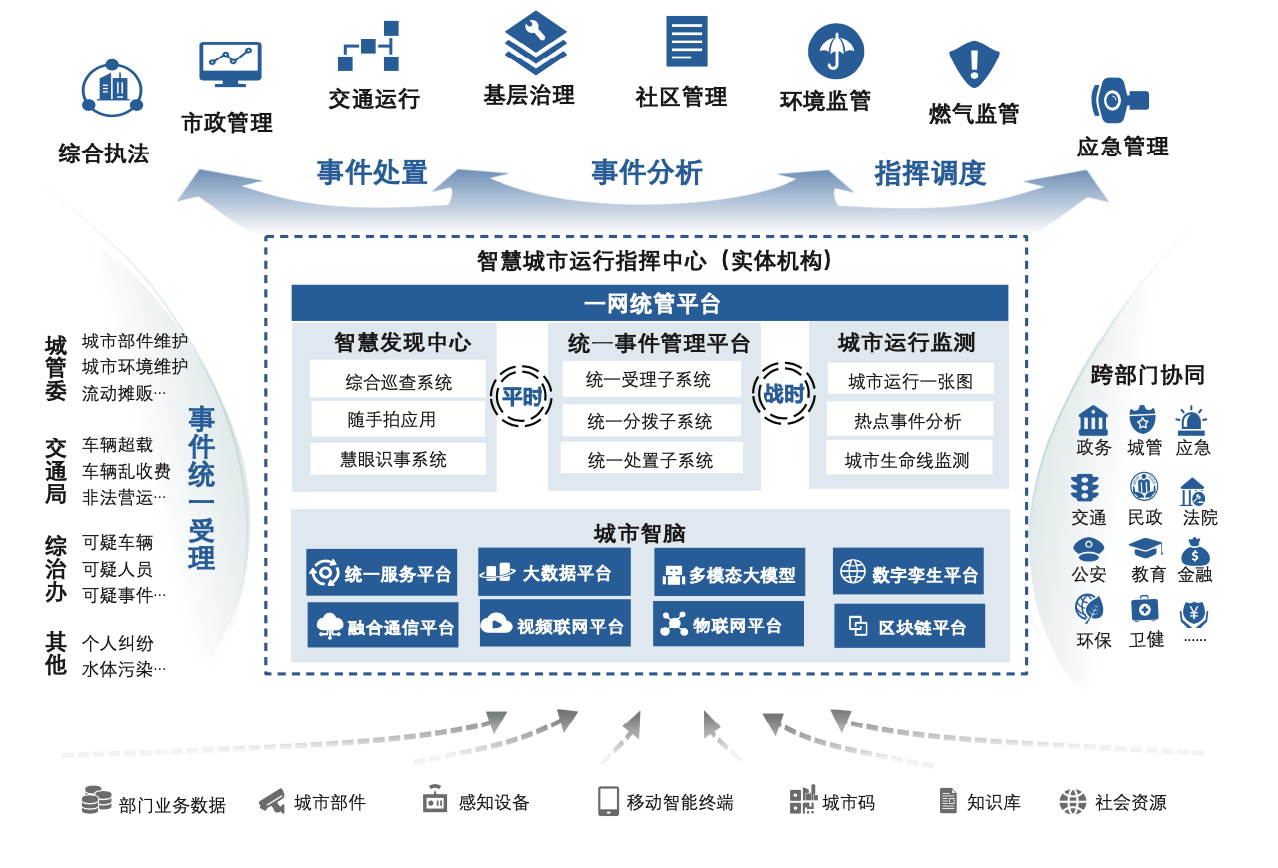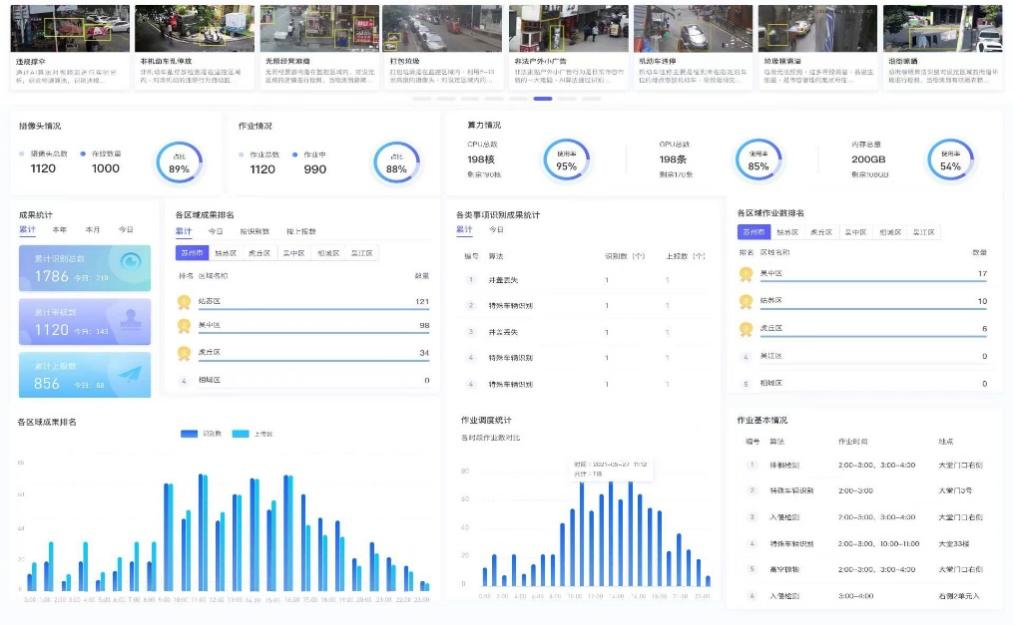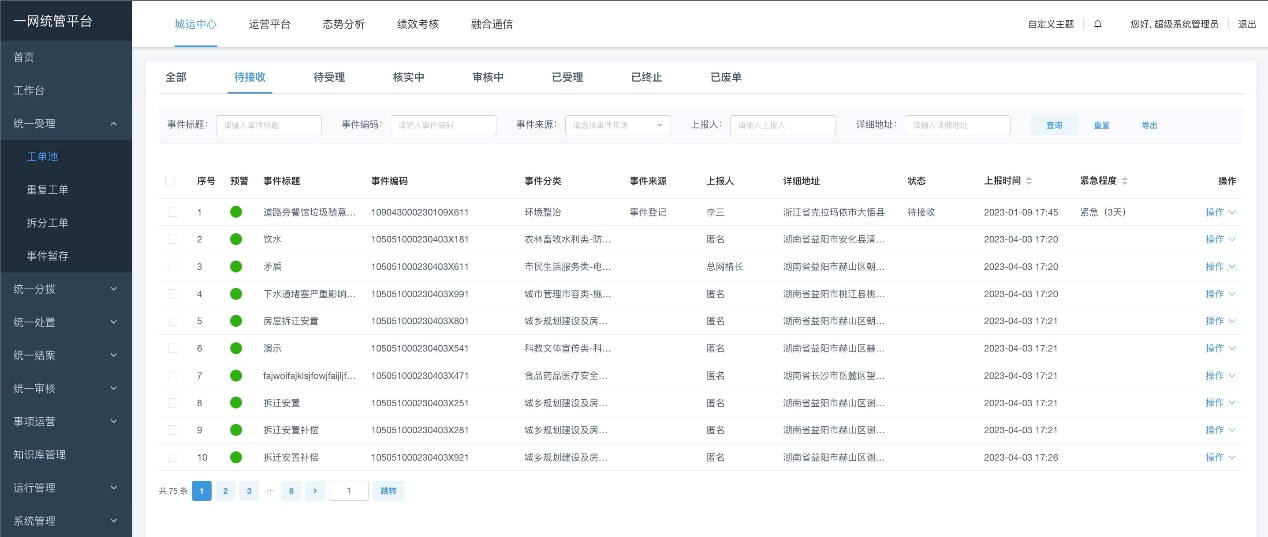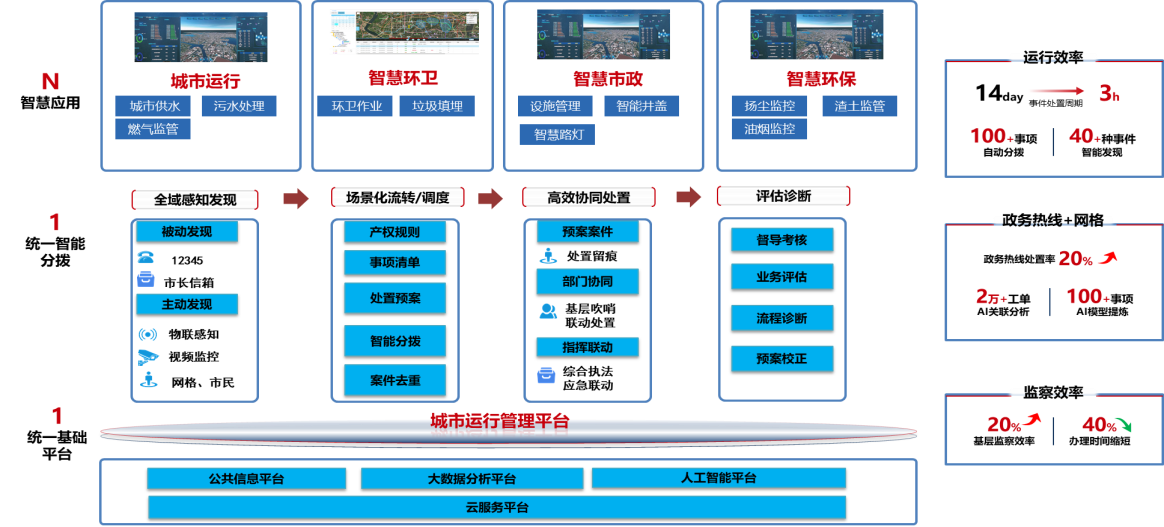

Digital Government and Smart Cities

The One-Stop Management System for Urban Governance solution takes the modernization of the urban governance system and governance capacity as the core, has the urban operation command center as the operating entity, makes full use of the next-generation information technology, builds an integrated urban operation management platform, fully integrates urban problems reported from multiple channels such as hotlines, apps, grids, perception equipment, business systems, etc., and coordinates the disposal power of various departments such as urban management, comprehensive management, environmental protection, transportation, natural resources, etc., reshapes business processes and operation mechanisms, effectively promoting cross-department, cross-regional, cross-level, and cross-system business collaboration and resource linkage and finally achieving the goal of "efficient processing of one thing". At the same time, it integrates cross-domain urban data for comprehensive analysis to realize situational awareness, monitoring and early warning, scientific decision-making, and overall scheduling of urban operation, and finally creates a new paradigm of scientific, refined, and intelligent urban "wisdom governance".

1. AI empowers and promotes the digital governance of cities:Intelligent customer service is built based on large-scale models. It accurately identifies user intentions through humanized interaction, provides quick answers, and helps solve various urban problems through easy chat. Through video intelligent identification technology, it can intelligently determine violations in various areas of the city, realize automatic early warning, reporting and intelligent distribution, and effectively improve the level of urban governance intelligence.
2. Standardize matters to reshape the departmental processing workflow: For various urban events, the solution has put together a list of 1,000 + matters based on past project experience, and sorted out the specifics of incident scenarios, handling criteria, and authorities suitable for most cities, and integrated and optimized the processing workflow, providing a unified reference for the accurate allocation of events and efficient processing and supporting efficient collaboration across departments based on unified rules.
3. Establishing a business closed loop for "efficient handling of one thing": The solution unifies and aggregates urban events from all channels and multiple types, establishes a business closed loop for the entire process of event acceptance, review, allocation, disposal, closure, and evaluation, and greatly improves the synergy efficiency of urban governance business across departments, levels, and systems.
4. Data fusion to achieve rapid early warning, accurate research and judgment, and rapid response to risk issues: The solution gathers geographic information, surveillance footage, Internet of Things perception, population, traffic, and other information resources and business data from various departments. Through data fusion analysis, it can achieve dynamic perception, accurate research and rapid response to risk issues and finally form an overall urban management and control capability of "one picture overview, one screen decision, one trigger, one command network".


Architecture of the One-Stop Management System for Urban Governance

The One-Stop Management System for Urban Governance focuses on "efficiently handling one thing" and preventing and resolving major risks. It aims to explore the concept and model of life cycle management that is compatible with urban development. Through the integration and innovation of organizational mechanisms, business, and technology, it resolves the fragmentation and inefficiency of existing urban management, speeds up business process overhaul, improves the efficiency of cross-departmental collaborative disposal, promotes social diversity and co-governance, continuously enhances the sense of gain, happiness, and security of citizens, and continuously promotes urban governance to a new stage of integrated development and efficient intelligence.

Scenario 1: Comprehensive community governance application
Through the construction of a comprehensive community inspection system, the solution can perform scientific management of "people, land, objects, affairs, organizations", and other governance objects, help grid personnel rationally plan inspection matters and inspection tasks, and reduce the repeated collection of information. It can also deal with general public security management, environmental health, and other issues found in the inspection on the site, save human resources investment, and effectively improve the efficiency of incident processing. At the same time, through integration with the urban operation management platform, the whole-process supervision and management is achieved, and a new model of efficient, agile, up-and-down linkage grassroots social governance is built.
Scenario 2: Dynamic correlation management service for occupied properties
In response to the problems of "unclear population base number and little basic information" in the management of housing at the grass-roots level, Beiming software builds a "one-stop online" grass-roots inspection system to help community managers comprehensively collect data on the registered population, permanent residents, migrants, commercial housings, self-built housings, etc. in the jurisdiction. Through the integration of the government big data platform, the automatic comparison and verification of multi-sector data is realized, and a standard population database and housing database are formed to achieve the governance effect of "finding people by their housings, finding housings by their occupants, knowing the occupants through the housings, and knowing housings through the people".
Scenario 3: The AI intelligent recognition of urban chaos and violations
The platform uses the existing urban video surveillance system and combines AI algorithms to analyze surveillance videos to achieve 24-hour uninterrupted identification of abnormal/illegal events such as "illegal road occupancy operations, illegal advertising, street trash, exposed garbage, illegal motor vehicle occupancy, store operations over their spatial limits, muck truck spills, and illegal crowd gathering", and intelligent early warning and reporting. Through the integrated distribution and circulation performed by the urban transportation center, the closed loop of event handling is constructed, which effectively improves the level of refinement, efficiency, and intelligence of urban governance.
Scenario 4: The intelligent soot index monitoring application
The platform realizes the dual supervision of soot emission, namely qualitatively (whether the soot purifier is turned on as required) and quantitatively (soot concentration analysis), in catering enterprises through the integration with soot monitoring equipment and real-time monitoring data of soot emission. When the fume purifier is abnormally shut down or the fume concentration exceeds the standard, the alarm information is automatically generated and immediately pushed to the local city operation command center and relevant disposal departments, supervision units, etc. for event processing, forming a closed-loop supervision mode. By analyzing and mining the data of restaurant fume emission from catering enterprises, the source of fume pollution can be found in a timely manner, and the behavior of enterprises can be scientifically and reasonably regulated.

The One-Stop Management System for Urban Governance of Wuhan
The One-Stop Management System for Urban Governance of Yiyang, Hunan
 The One-Stop Management System for Urban Governance of Wugang, Henan
The One-Stop Management System for Urban Governance of Wugang, Henan